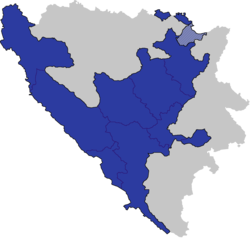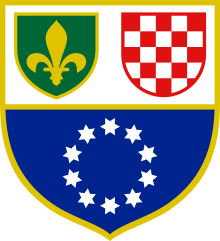
Demographic features of the population of Bosnia and Herzegovina include population density, ethnicity, education level, health of the populace, economic status, religious affiliations and other aspects of the population.
The politics of Bosnia and Herzegovina are defined by a parliamentary, representative democratic framework, where the Chairman of the Council of Ministers of Bosnia and Herzegovina, named by the Presidency of Bosnia and Herzegovina, is the head of government. Executive power is exercised by the Council of Ministers of Bosnia and Herzegovina and the Presidency of Bosnia and Herzegovina. Legislative power is vested in both the Council of Ministers and the Parliamentary Assembly of Bosnia and Herzegovina. Members of the Parliamentary Assembly are chosen according to a proportional representation system. The judiciary is independent of the executive and the legislature.

The General Framework Agreement for Peace in Bosnia and Herzegovina, also known as the Dayton Agreement or the Dayton Accords, and colloquially known as the Dayton in ex-Yugoslav parlance, is the peace agreement reached at Wright-Patterson Air Force Base near Dayton, Ohio, United States, finalised on 21 November 1995, and formally signed in Paris, on 14 December 1995. These accords put an end to the three-and-a-half-year-long Bosnian War, which was part of the much larger Yugoslav Wars.

Republika Srpska is one of the two entities of Bosnia and Herzegovina, the other being the Federation of Bosnia and Herzegovina. It is located in the north and east of the country. Its largest city and administrative centre is Banja Luka, lying on the Vrbas river, and with a population of about 138,963 people.
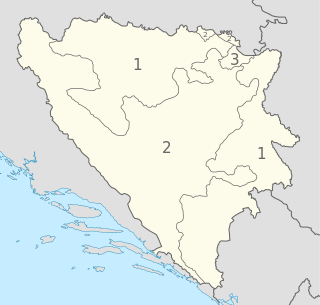
The political divisions of Bosnia and Herzegovina were created by the Dayton Agreement. The Agreement divides the country into two federal entities: the Federation of Bosnia and Herzegovina (FBiH) and the Republika Srpska (RS) and one condominium of the two entities named the Brčko District.
There is currently no official flag for the Federation of Bosnia and Herzegovina. The federation is part of the state of Bosnia and Herzegovina. The federation adopted its own flag in 1996, but the flag and associated coat of arms were deemed unconstitutional by the Constitutional Court of Bosnia and Herzegovina in 2007 and now it is considered to be a "de facto" flag. The federation has not yet adopted a new flag, anthem or coat of arms; instead the symbols of the central state are used for official purposes as a provisional solution.
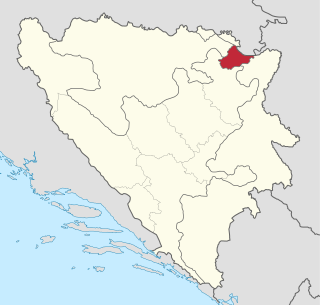
Brčko District, officially the Brčko District of Bosnia and Herzegovina, is a self-governing administrative unit in north-eastern Bosnia and Herzegovina.

The Republika Srpska was a self-proclaimed statelet in Southeastern Europe under the control of the Army of Republika Srpska during the Bosnian War. It claimed to be a sovereign state, though this claim was only partially recognized by the Bosnian government in the Geneva agreement, the United Nations, and FR Yugoslavia. For the first six months of its existence, it was known as the Serbian Republic of Bosnia and Herzegovina.
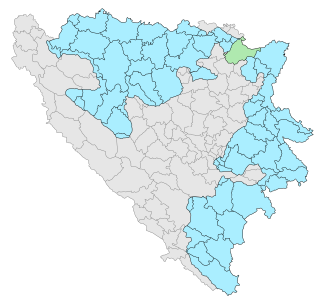
Under the "Law on Territorial Organization and Local Self-Government" adopted in 1994, Republika Srpska was divided into 80 municipalities. After the conclusion of the Dayton Peace Agreement, the law was amended in 1996 to reflect the changes to the entity's borders and now provides for the division of Republika Srpska into 64 municipalities.
Four major international peace plans were proposed before and during the Bosnian War by European Community (EC) and United Nations (UN) diplomats before the conflict was settled by the Dayton Agreement in 1995.

This article is about the Demographic history of Bosnia and Herzegovina, and deals with the country's documented demographics over time. For an overview of the various ethnic groups and their historical development, see Ethnic groups in Bosnia and Herzegovina.

The Inter-Entity Boundary Line, commonly abbreviated IEBL, is the administrative line that subdivides Bosnia and Herzegovina into two entities, Republika Srpska and the Federation of Bosnia and Herzegovina. The total length of the Inter-Entity Boundary Line is 1,080 km.
The Constitution of Bosnia and Herzegovina was amended once, in 2009, to include the outcome of the Brčko District final award. Several constitutional reforms were attempted between 2006 and 2014, to ensure its compliance with the case law of the European Convention on Human Rights in the Sejdić and Finci v. Bosnia and Herzegovina and following cases regarding ethnic- and residence-based discrimination in passive electoral rights for the Presidency and House of Peoples. None of these attempts have been successful so far, notwithstanding EU involvement and conditionality.

The Republic of Bosnia and Herzegovina was a state in Southeastern Europe, existing from 1992 to 1995. It is the direct legal predecessor to the modern-day state of Bosnia and Herzegovina.

General elections were held in Bosnia and Herzegovina on 1 October 2006. They decided the makeup of Bosnia and Herzegovina's Presidency as well as national, entity, and cantonal governments.
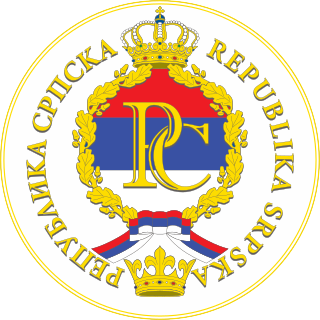
The Seal of Republika Srpska with the description: the flag of Republika Srpska and the Cyrillic letters "РС" ("RS"), the red-blue-white tricolor are in the center of the seal, twisted with the golden Oak leaves, a traditional pre-Christian symbol sacred to most Slavs. On the edge of the seal there is an inscription Republika Srpska. The open crown of Kotromanić is shown in the bottom of the seal and the seal itself is topped with a heraldic royal crown.
The Croatian National Assembly is a political organisation of Croat political parties in Bosnia and Herzegovina. The organisation serves as a platform to coordinate political and cultural activities of different parties and stakeholders in the Croatian community and to promote the initiative to create a federal unit with Croatian majority in the country.

The Croat federal unit in Bosnia and Herzegovina, or Croat entity, also informally known as the third entity, is a proposed administrative unit in Bosnia and Herzegovina based on territorial federalism and ethnic self-determination. The proposal has been invoked by several political scientists, politicians and political parties, including the Croat National Assembly. So far it has not been discussed beyond the concept level. Since the country is divided into two entities, the Serb-dominated Republika Srpska and the Bosniak-majority Federation, Croats, as one of the three equal constitutive nations, have proposed creating a symmetrical Croat-majority territorial unit. Political advocates for such proposal argue it would ensure Croat equality and prevent electoral gerrymandering, simplify the political gridlock while dismantle overburdening administration. Opponents argue it would further divide the country on ethnic grounds thus breaching the constitutional principles, put non-Croats in a subordinate position, and lead to separatism.

General elections were held in Bosnia and Herzegovina on 7 October 2018. They decided the makeup of Bosnia and Herzegovina's Presidency as well as national, entity and cantonal governments. Voter turnout was 54%.
